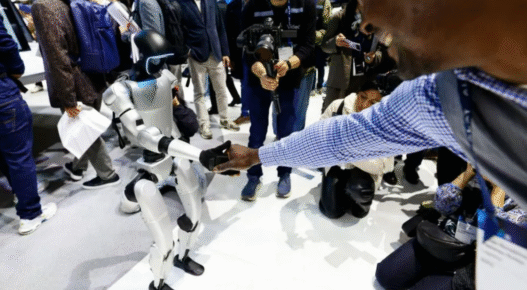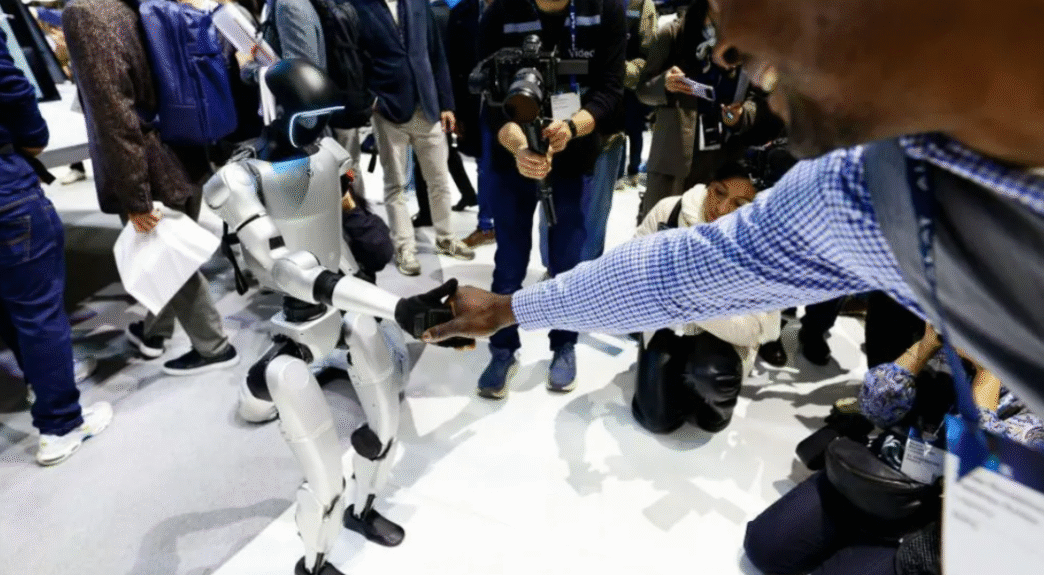At the prestigious Hannover Messe industrial trade show in Germany, Chinese firm Unitree has been attracting significant attention with its G1 humanoid robot. Standing approximately 4’3″ (130cm) tall, the G1 represents a more compact and affordable option in the emerging humanoid robot market. Its impressive range of motion and dexterity have made videos of its dance routines and martial arts demonstrations go viral across social media platforms.
The G1’s human-like form elicits unique interactions from trade show attendees, who instinctively reach out to shake its hand, test its responsiveness with sudden movements, and even apologize if they accidentally bump into it. This natural engagement highlights how the humanoid design, despite its uncanny aspects, creates an inherent comfort level that other industrial machines fail to achieve.
“There’s something fundamentally appealing about robots that mirror our own form,” explains robotics expert Dr. Elaine Murray from the Robotics Innovation Institute. “The human brain is wired to connect with human-like shapes, which creates both practical and psychological advantages for certain applications.”
The Business Case for Humanoid Robots
The business potential for humanoid robots is substantial. For companies, they promise a workforce that doesn’t require vacations, sick leave, or salary increases. In domestic settings, they could revolutionize household management by handling various chores from laundry to dishwashing.
However, significant technological challenges remain before widespread adoption becomes feasible. While robotic arms and mobile robots have been staples in controlled environments like factories and warehouses for decades, introducing humanoid robots into unpredictable settings such as restaurants or homes presents far more complex problems.
For humanoid robots to be useful, they must possess considerable strength, which paradoxically makes them potentially dangerous. Even a simple fall at an inopportune moment could pose serious hazards to nearby humans. This necessitates sophisticated artificial intelligence systems to ensure safe operation.
“The AI simply has not yet reached a breakthrough moment,” a Unitree spokesperson told investigators. “Today’s robot AI finds basic logic and reasoning – such as for understanding and completing complex tasks in a logical way – a challenge.”
Currently, Unitree markets the G1 primarily to research institutions and technology companies that can utilize their open-source software for further development and customization.
Industrial Applications Lead the Way
Most entrepreneurs are focusing their immediate efforts on developing humanoid robots for warehouses and factories. Tesla’s Elon Musk has been particularly vocal about his company’s humanoid robot called Optimus. In January, Musk announced plans to build “several thousand” units this year, expecting them to perform “useful things” in Tesla factories.
Other automotive manufacturers are following similar strategies. BMW recently introduced humanoid robots to a US manufacturing facility, while Hyundai has ordered tens of thousands of robots from Boston Dynamics, which it acquired in 2021.
According to Thomas Andersson, founder of research firm STIQ who tracks companies developing humanoid robots, Chinese firms are positioned to dominate this emerging market. As detailed in analysis from 1stNews24, “China’s manufacturing ecosystem provides unparalleled advantages in robotics development, from component sourcing to rapid prototyping capabilities.”
“The supply chain and the entire ecosystem for robotics is huge in China, and it’s really easy to iterate developments and do R&D,” Andersson explains. Unitree exemplifies this advantage with its G1 robot priced at a relatively affordable $16,000 (£12,500).
Investment patterns also favor Asian nations, with STIQ reporting that nearly 60% of all funding for humanoid robots has been raised in Asia, while the US attracts most of the remainder. Chinese companies benefit further from substantial national and local government support, including state-backed training facilities where numerous humanoid robots learn to complete various tasks.
Western Innovation Approaches
Western robotics companies are developing strategic approaches to remain competitive. Bristol-based entrepreneur Bren Pierce, who has founded three robotics companies, recently launched the KR1 robot through his latest venture, Kinisi. While designed and developed in the UK, the robot will be manufactured in Asia.
“The problem you get as a European or American company, you have to buy all these sub-components from China in the first place,” Pierce explains. “So then it becomes stupid to buy your motors, buy your batteries, buy your resistors, shift them all halfway around the world to put together when you could just put them all together at the source, which is in Asia.”
To maintain cost-effectiveness, Pierce has designed the KR1 without legs, recognizing that warehouses and factories typically have flat floors that don’t require the added complexity and expense of bipedal movement. Where possible, the KR1 incorporates mass-produced components, such as electric scooter wheels, to keep costs down.
“My philosophy is buy as many things as you can off the shelf. So all our motors, batteries, computers, cameras, they’re all commercially available, mass-produced parts,” he says.
Both Unitree and Kinisi emphasize that the true differentiator in robotics is the software that enables seamless human-robot interaction. Pierce aims to create robots that don’t require advanced technical knowledge to operate.
“What we’re trying to design is a very simple to use robot where your average warehouse or factory worker can actually learn how to use it in a couple of hours,” Pierce says, noting that the KR1 can learn to perform tasks after being guided through them by a human 20-30 times.
The Future of Home Robotics
Despite the rapid advancement in robotics technology, experts remain cautious about predicting when truly versatile humanoid robots might enter our homes. Even optimistic industry insiders like Pierce suggest it remains a distant prospect.
“My long-term dream for the last 20 years has been building the everything robot. This is what I was doing my PhD work in. I do think that is the end goal, but it’s a very complicated task,” says Pierce. “I still think eventually they will be there, but I think that’s at least 10 to 15 years away.”
As the competition intensifies, the question remains not just who will win the race to develop practical humanoid robots, but also which approaches to design, manufacturing, and artificial intelligence will ultimately prevail in this transformative technology.




















